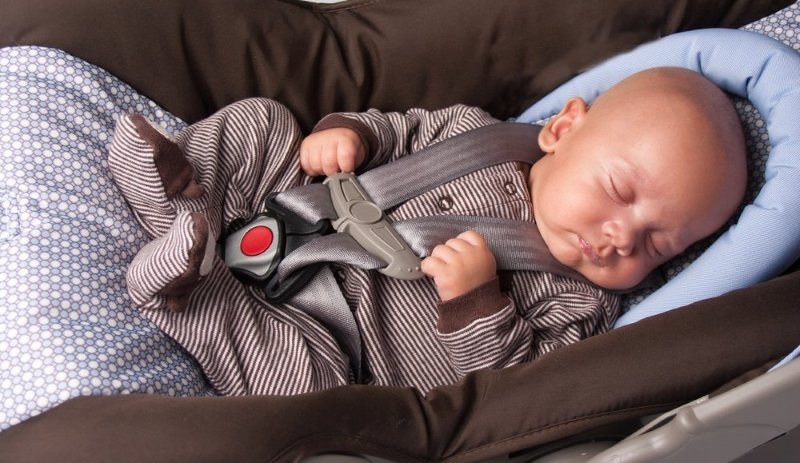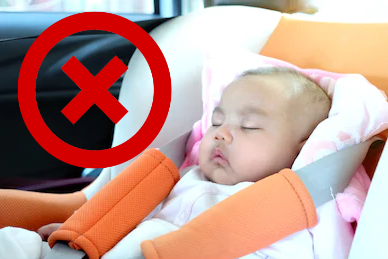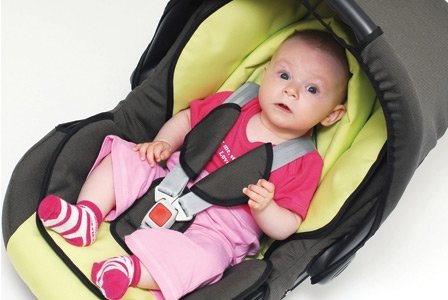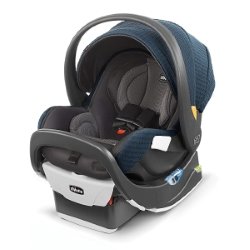
New parents often worry around the position of their newborn’s head. However, what you may think looks safe may not actually be the best position for your child’s head. Observe your baby when he’s sleeping in his bassinet. You’ll notice that his head will most often be turned to one side.
Same goes when you hold them on your shoulder or wear them in a sling. Turning their heads to one side is the most natural way for them to breathe. When some parents see babies with their heads turned to one side in a car seat, however, they think the baby isn’t positioned right.
That’s when they’ll turn to padded head supports (aka infant inserts) or even rolled up receiving blankets to hold their heads straight up. Unfortunately, these additions can push the baby’s head down onto his chest, which is dangerous because it can obstruct the airway. This is especially true for any aftermarket products that didn’t come with the car seat.
So, how do you ensure your newborn is safely positioned?
First, make sure he’s rear-facing
This should go without saying, but a newborn baby up to a minimum of 2 years (preferably longer), should always ride in a rear-facing car seat. These seats provide enough support for the head, neck and spine to absorb crash forces to prevent injury to a baby’s delicate spinal column. Plus they recline to the proper angle to keep airways open.
Avoid aftermarket head supports

If it didn’t come with your car seat, then don’t use it. This is a good rule to follow with all car seat accessories, especially for infants. The only time you should use something that didn’t come with the seat is if the manufacturer has given their OK. This includes any aftermarket infant inserts or rolled up receiving blankets used as head supports. You could void the warranty or put your baby at risk if you use these.
Generally it’s okay to use the infant inserts that come with your car seat, but ONLY if your baby’s head is not pushed onto his chest. If the insert pushes your baby’s head forward, check the owner’s manual, and if it says you’re allowed to remove it, then do so.
We’ve even recommended removing the insert in some of our car seat reviews, including the Chicco Fit2. It’s great for babies 4 – 35 pounds and has a toddler position to allow a better fit for extended rear facing. With the push-on LATCH connectors, it’s super easy to install. Safety features include an anti-rebound bar and large headrest with padded wings.
Get the right recline angle

Newborns have very little head control due to weak neck muscles. So they should be reclined to prevent their heads from slumping forward.
Every infant car seat has a guide to show you how much you need to recline the seat for a newborn. The most reclined angle is usually the safest for very young babies.
Pay attention to what parents say about recline in car seat reviews. Some car seats will not recline properly in all vehicles, even when you’ve set the recline angle to the lowest it can go. Cars with bucket seats or seats with a steep incline are particularly problematic. You may be able to adjust the recline with pool noodles or rolled towels placed under the car seat, but ONLY if the manufacturer recommends that method.
Head, neck and hips should be inline
Overall, if you draw an invisible line from the top of your baby’s head to her bottom, it should be straight. Meaning, that her head, spine and hips should all be lined up straight. If her body is curved, her neck could be in a slump, which is bad for her future mobility and can obstruct the airway.

Get those straps snug
The best way to keep your baby’s spinal column in line is to ensure the harness straps are snug enough. The shoulder straps should be snug enough to fit only one finger beneath them. If you can fit two fingers stacked on each other under the straps, they’re too loose. Tighten them and check again, repeating until it’s right.
Once the shoulder straps are tight, make sure the chest clip is adjusted to lie right across the chest in line with your baby’s armpits. Any lower may allow her head to slump forward, and if you’re in a crash, the chest clip could push into her organs, causing serious damage.
The crotch buckle should be as close to the baby’s bottom as possible to keep the baby from slouching down in the seat. If you’ve tightened it as far as you can, and there’s still a gap, you may be able to use a tightly rolled washcloth in a U-shape along the baby’s inner thighs after she’s buckled in. However, consult with the manufacturer first to see if this is allowed.
Proper installation
Overall, the most important thing you can do to ensure your child is safe in the car seat is to make sure it’s installed properly! Opt for a seat with simple installation to lower the chances of user error. Once installed, have a licensed child passenger safety tech, your pediatrician, or a police officer to double check that it’s done correctly.
Look online to find a CPS (child passenger safety) Technician in your area. They can also help you determine if your baby’s positioned correctly.

How do they poop in there
Because they need to
Take a poo. Poo
Rtf Highbury nutcracker looking